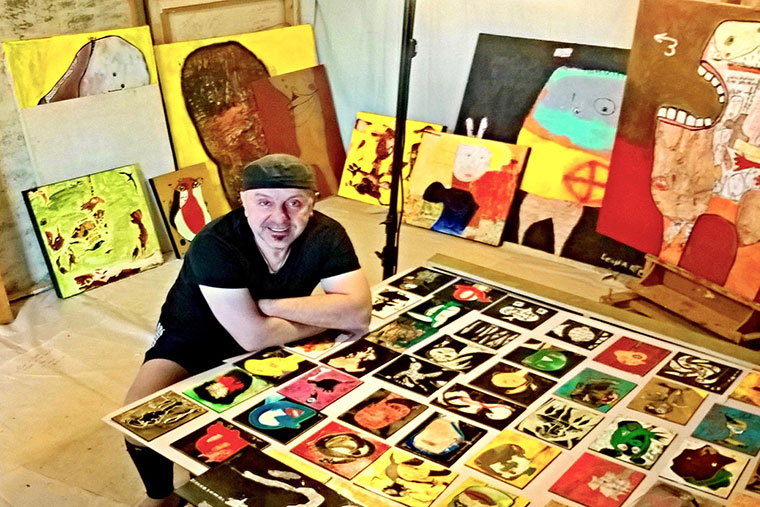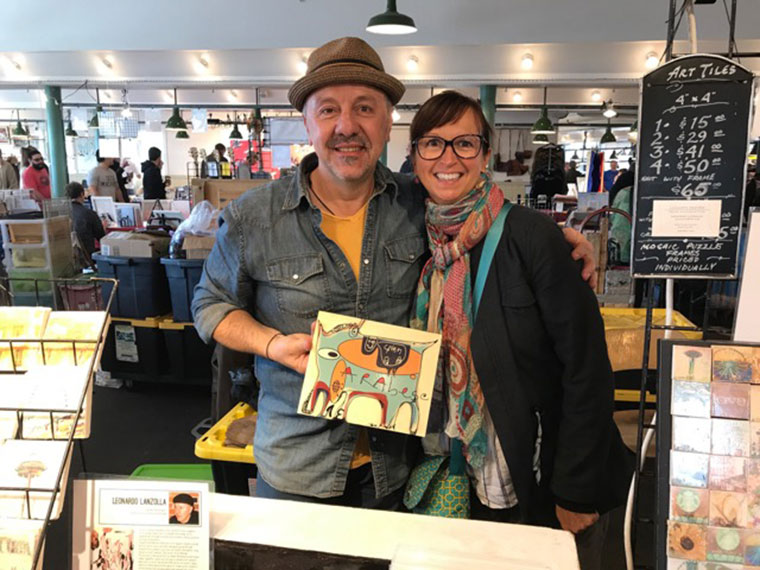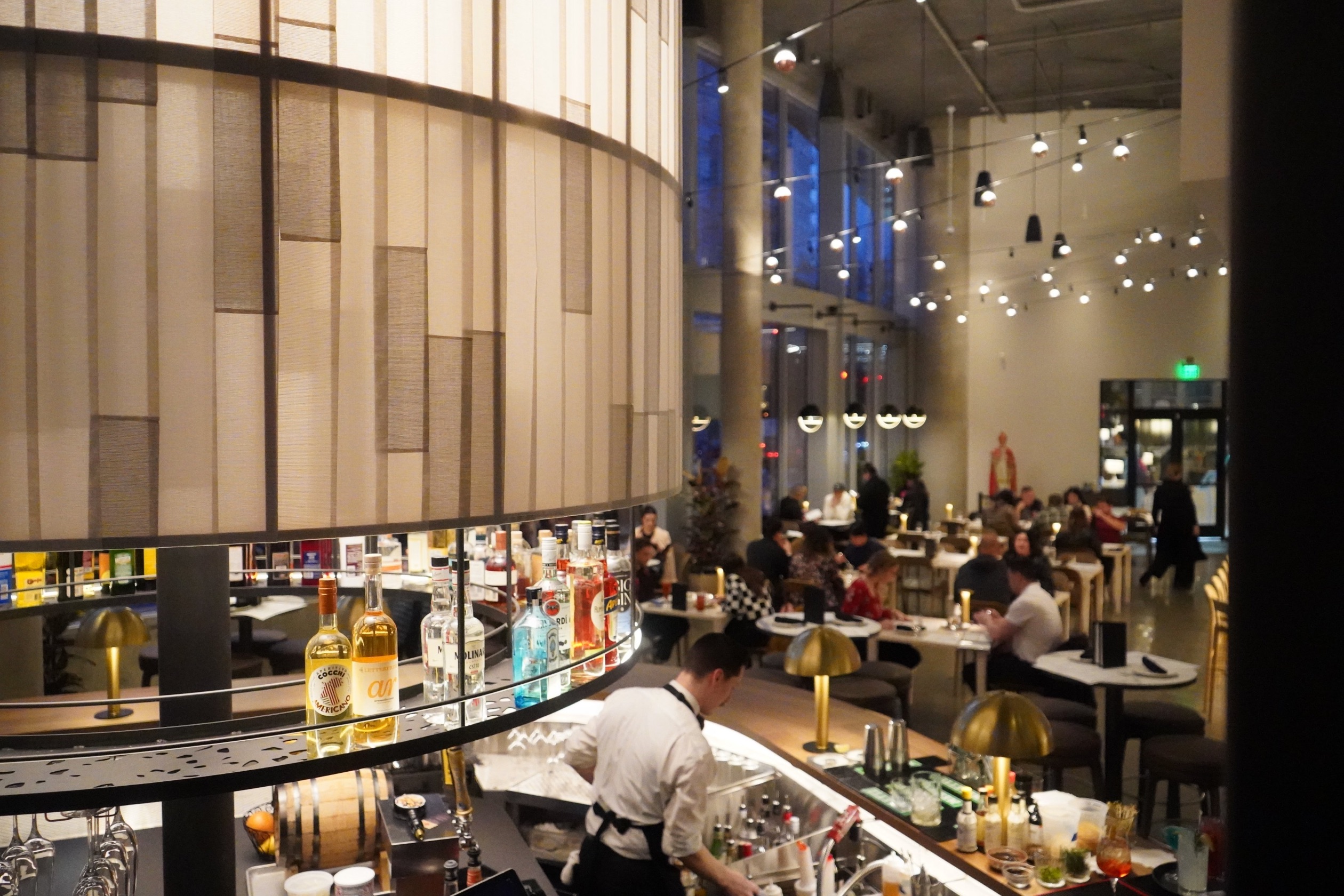Fresh, intuitive and original, Leonardo Lanzolla’s artwork mixes semi-abstract objects, geometric shapes, bold colors and organic forms to create a universe that is pulsing with life. He uses a process called sgraffito, a technique with roots in Renaissance Italy, where the artist applies layers of color to a surface and then scratches or carves it away to create an image.
Born in Torino, Italy, in 1958, Lanzolla was drawn to the world of art as a young child. Captivated by the wide open spaces of the US, he moved to California in 1984 and settled in Seattle two years later. As he worked to establish his art career, he supported himself in various ways as artists tend to do, working as a language teacher, theater producer, actor and restaurant server.
Lanzolla exhibits his work regularly. He has had solo shows in New York City, Scottsdale, Ariz., and throughout Washington state as well as in Avignon, France, and Stockholm, Sweden. On weekends you can find him at his booth at Pike Place Market, selling his distinctive prints and stone tiles. We had coffee with Lanzolla recently in West Seattle, the neighborhood he now calls home.

Lanzolla takes his inspiration from many different sources, ranging from artists such as Klee and Picasso to folk art and cave paintings
Did you train as an artist in Italy?
I never studied art formally. My dad had a small business selling mechanical tools to fix cars and he also ran a hardware store. After high school, I went to school in the evenings where I earned a business degree, similar to a CPA program. That freed me up during the day to work with my dad. He wanted me to follow him into the business but it did not interest me. I saw myself as more artistic than that.
When did you decide that art was your calling?
I was very artistic since the age of about 8. I loved to create something from nothing, to give shape to things. My friends used to call me “Artista” or “Il Professore.” For me, the written word was limited. I needed a more visual vocabulary. I wanted a way to explain myself in my own language. Art was a natural way for me to tell my story.

Every weekend, Lanzolla is at his booth at Pike Place Market, where tourists and residents alike can view and buy his artwork and art tiles
Did your interest in expressing yourself lead you into theater work?
I was attracted to movies and plays, studying how they interpreted characters. I was told I had a good voice for broadcasting and acting. I enrolled in the Little Drama School of Torino and took classes in diction, voice-over. I studied at the school for three years and got a diploma there.
Why did you decide to move to the United States?
I wanted to come to the US ever since I saw Neil Armstrong land on the moon in 1969. I liked how American universities combined sports and study. You don’t find that in Italy. I was also attracted by the sheer size of the country. There is no space in Italy to generate things. I find it so confining there.

For more than 30 years, Lanzolla has been part of the art scene in Seattle and currently exhibits at Gallery 110, shown here
Before making such a big decision, though, I decided to experience Rome first. I went there one summer in the mid-1980s and auditioned for several theater productions as well as radio and TV. I got my first acting part in a traveling company for a production of Pinocchio. At the same time, I was creating art. One day, I sold 5 or 6 drawings in Piazza Navona. I made some even bigger drawings and sold those, too. That gave me ideas about producing art and selling it. I ended up spending about two years in Rome.
When did you first exhibit your work?
When I was still in Rome, some student artists who lived in my building came into my room one day. They saw my drawings hanging on the wall and said: whose art is this? Where did it come from? When I told them it was mine, they were amazed. They invited me to exhibit my work with them at a gallery event in Campo de’ Fiori. It was kind of a pop-up show, just for one night, called “Raw Rome.”
New York is known for its art scene but you choose Los Angeles. Why?
I chose LA because it seemed like it had a lot of opportunities, plus it was sunny there. I went with my friend Roberto. When we bought our tickets, the flights to New York were cheaper so that’s where we landed. We then got on a Greyhound bus and rode across the country for three days. Even though I liked LA, I was not quite ready to settle there. I went back to Italy but now everything there seemed so slow. Two years later, I moved back to the US, first to Los Angeles, then Billings, Montana, and then Seattle, where I met my wife. I’ve been here ever since.
Tell us about more about your art.
I call myself an urban visionary artist. My paintings reflect the nature of mankind, modern life and the senses. I investigate the human experience through colors, shapes, epigraphs. Using sgraffito allows me to be flexible. I carve away color, but sometimes I add more color to the area I just carved. This technique gives me the freedom to approach my art from different creative angles.
What are your plans for this year?
I am working on a solo show called “Visions of Global Influence” that will open in January 2019 at Gallery 110 in Seattle’s Pioneer Square. The exhibit explores visionary characters and creatures, tracing their words and symbols as expressions of global influence.






























